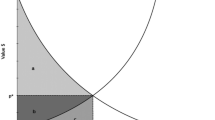Abstract
The use of crime scenarios in sample surveys is the principal method for assessing public valuations of crime seriousness. The adequacy of this method is heavily dependent upon the a priori assumptions of the researchers constructing these scenarios. If crucial attributes of crime incidents are omitted from these descriptions of a crime, then resulting seriousness scores and weights will be in error. This paper proposes an alternative method of assessing crime seriousness—the Hedonic Price Index approach—that is not as dependent upon the prior assumptions of those building scenarios. This approach can be used as a complement to scenario methods to further our understanding of the evaluation of crime seriousness.
Similar content being viewed by others
References
Akman, D. D., Normandeau, A., and Turner, S. (1967). The measurement of delinquency in Canada.Crim. Law Criminal. Police Sci. 58:330–337.
Barnett, C. L. (1981).Using Hedonic Indexes to Measure Housing Supply Response to Housing Allowances, Rand, Santa Monica, CA.
Berndt, E. R. (1991).The Practice of Econometrics: Classic and Contemporary. Addison-Wesley, Reading, MA.
Blum-West, S. R. (1985). The seriousness of crime: A study of popular morality.Deviant Behav. 6:83–98.
Blumstein, A. (1974). Seriousness weights in an index of crime.Am. Sociol. Rev. 39:854–864.
Blumstein, A., and Cohen, J. (1980). Sentencing of convicted offenders: An analysis of the public's view.Law Soc. Rev. 14:223–261.
Cox, B. G., and Collins, J. J. (1985).Crime Victimization in the District of Columbia: A Report to Congress and the District of Columbia Government, Research Triangle Institute, Research Triangle Park, NC.
Cullen, T., Link, G., and Polanzi, W. (1982). The seriousness of crime revisited: Have attitudes toward white-collar crime changed?Criminology 20:83–102.
Cullen, F. T., Link, B. G., Travis, L. F., III, and Wozm'ak, J. F. (1985). Consensus in crime seriousness: Empirical reality or methodological artifact?Criminology 23:99–118.
Durham, A. M., III (1986). The use of factorial survey design in assessments of public judgments of appropriate punishment for crime.J. Quant, Criminol. 2:181–190.
Figlio, R. M. (1975). The seriousness of offenses: An evaluation by offenders and nonoffenders.J. Crim. Law Criminol. 66:189–200.
Follain, J. R., and Malpezzi, S. (1980).Dissecting Housing Value and Rent: Estimates from Hedonic Indexes for 39 Large SMSAs, Urban Institute, Washington, DC.
Galvin, J. M.List versus Transaction Price as Dependent Variables in a Hedonic Price Function for New Automobiles, Unpublished M.A. thesis, George Washington University, Washington, DC.
Gibbons, D. C. (1969). Crime and punishment: A study in social attitudes.Soc. Forces 47:391–399.
Gottfredson, S. D., Young, K. L., and Laufer, W. S. (1980). Additivity and interactions in offenses seriousness scales.J. Res. Crime Delinq. 17:26–41.
Hsu, M. (1973). Cultural and sexual differences on the judgment of criminal offenses: A replication study of the measurement of delinquency.J. Crim. Law Criminol. 64:348–353.
Jacoby, J. E., and Dunn, C. S. (1987). National Survey on Punishment for Criminal Offenses. Executive Summary prepared for presentation at the National Conference on Punishment for Criminal Offenses, Ann Arbor, MI.
Miethe, T. D. (1982). Public consensus on crime seriousness: Normative structure or methodological artifact?Criminology 20:515–526.
Miethe, T. D. (1984). Types of con sensus in public evaluations of crime: An illustration of strategies for measuring “consensus.”J. Crim. Law Criminol. 75:459–473.
Miethe, T. D. (1987). Stereotypical conceptions and criminal processing: the case of the victim-offender relationship.Just. Q. 4:571–593.
Normandeau, A. (1966). The measurement of delinquency in Montreal.J. Crim. Law Criminol. Police Sci. 57:172–177.
Pease, K., Ireson, J., and Thorpe, J. (1974). Additivity assumptions in the measurements of delinquency.Br. J. Criminol. 14:256–263.
Reidel, M. (1975). Perceived circumstances, inferences of intent and judgments of offense seriousness.J. Crim. Law Criminol. 66:201–208.
Rossi, P. H., and Anderson, A. B. (1982). The factorial survey approach: An introduction. In Rossi, P. H., and Nock, S. (eds.),Measuring Social Judgments, Sage, Beverly Hills, CA.
Rossi, P. H., and Nock, S. L. (1982).Measuring Social Judgements: The Factorial Survey Approach, Sage, Beverly Hills, CA.
Rossi, P. H., Waite, E., Bose, C. E., and Berk, R. E. (1974). Seriousness of crimes: Normative structure and individual differences.Am. Sociol. Rev. 39:224–237.
Rossi, P. H., Simpson, J. E., and Miller, J. L. (1985). Beyond crime seriousness: Fitting the punishment to the crime.J. Quant. Criminol. 1:59–90.
Sebba, L. (1984). Crime seriousness and criminal intent.Crime Delinq. 30:227–244.
Sellin, T., and Wolfgang, M. E. (1964).The Measurement of Delinquency, John Wiley and Sons, New York.
Taylor, D. G., Scheppele, K. L., and Stinchcombe, A. L. (1979). Salience of crime and support for harsher criminal sanctions.Soc. Problems 26:413–424.
Thomas, C. W., Cage, R. J., and Foster, S. C. (1976). Public opinion on criminal law and legal sanctions: An examination of two conceptual models.J. Crim. Law Criminol. 67:110–116.
Velez-Diaz, A., and Magargee, E. (1971). An investigation of differences in value judgments between youthful offenders and nonoffenders in Puerto Rico.J. Crim. Law Criminol. Police Sci. 61:549–553.
Warr, M. (1989). What is he Perceived seriousness of crimes? Paper presented at the American Sociological Association meetings, San Francisco, CA.
White, G. F. (1975). Public responses to hypothetical crimes: Effects of victim offender status and seriousness of offense on punitive reactions.Soc. Forces 53(3):411–419.
Wilman, E. A. (1981).External Costs of Coastal Beach Pollution: An Hedonic Approach, Resources for the Future, Washington, DC.
Wolfgang, M. E., and Figlio, R. M. (1984). The severity of crime.BJS Bulletin, Bureau of Justice Statistics, Washington, DC.
Wolfgang, M. E., Figlio, R. M., Tracy, P. E., and Singer, S. I. (1985).National Survey of Crime Severity, Bureau of Justice Statistics, Washington, DC.
Author information
Authors and Affiliations
Rights and permissions
About this article
Cite this article
Lynch, J.P., Danner, M.J.E. Offense seriousness scaling: An alternative to scenario methods. J Quant Criminol 9, 309–322 (1993). https://doi.org/10.1007/BF01064464
Issue Date:
DOI: https://doi.org/10.1007/BF01064464




